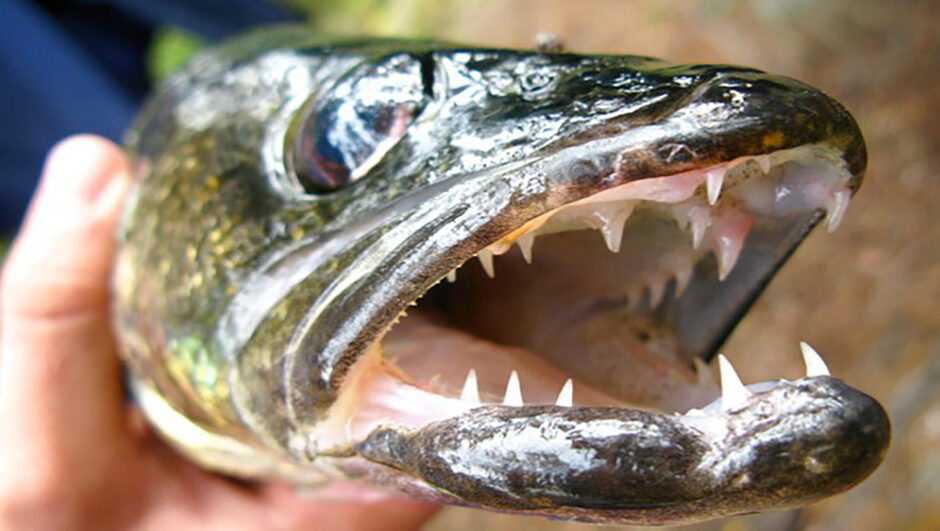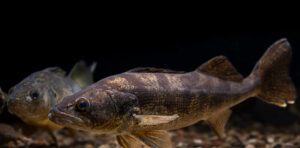Respecting Walleye Regulations for a Sustainable Fishing Future
 Close-up of the sharp teeth of a walleye held by a staff member of the Grand Junction Fish and Wildlife Conservation Office. (Credit: USFWS via Flickr Public Domain)
Close-up of the sharp teeth of a walleye held by a staff member of the Grand Junction Fish and Wildlife Conservation Office. (Credit: USFWS via Flickr Public Domain)Fun to catch and delicious to eat, walleye are a favorite sport fish for anglers across the United States and Canada. Commonly found throughout the Great Lakes, anglers flock to the region each year in search of walleye.
According to the U.S. Fish & Wildlife Service, walleye are freshwater predators in the perch family that have two dorsal fins and are generally olive or brown. Their non-spotted top dorsal fin and white lower-tipped tail differentiate them from their lookalike, saugers. The two species are close relatives but can be differentiated by the spotted top dorsal fin and all-dark lower tail of the sauger.
Walleye live in lakes and rivers with cooler water temperatures, prefering deeper waters during the day and shallow waters at night. With nocturnal eyesight from the tapetum lucidum layer on their eyes, walleye can see better in turbid water and low light, favoring night feeding.
Walleye Fishing Techniques
As prevalent game fish, walleye are caught by anglers using various techniques year-round. However, to get the best catch, anglers must regularly adjust their methods and sites because walleye become selective with the bait they pursue.
Picking a good time is also crucial for catching walleye, and the most promising time is at night or around dawn and dusk, so it’s just dark enough for them to see well. They’ll begin to hunt more than they would during the day, allowing anglers to catch them more easily.
According to the New York Department of Environmental Conservation, there are various ways to catch walleye, such as jigs, blade baits, crankbaits, stickbaits, and live bait rigs. Anglers can attach bucktails, marabou, dark plastic bodies, and live bait to jigs. Minnows, night crawlers, and leeches are popular live baits to attach to jigs and put in rigs.
Likewise, the Michigan Department of Natural Resources suggests switching to trolling or spoons during the winter because of the ice.
Walleye Fishing Regulations
Every public body of water has regulations that help manage fish populations and avoid overfishing as well as bycatch. State regulations require all fishermen to have a fishing license, allowing anglers to fish on all public state-specific waters. The state can see how many anglers are fishing, and they can promote sustainable fishing education through license sales.
For walleye, regulations differ depending on the state and lake; lake-specific regulations override statewide regulations. The average statewide walleye regulations, such as those in Michigan and New York, have a minimum length of 15 inches and a daily possession limit of 5.

Photographed at Gavins Point National Fish Hatchery in Yankton, SD (Credit: Sam Stukel / USFWS via Flickr Public Domain)
Minimum size regulations protect walleye spawning rates to ensure younger fish spawn before being caught, giving fish populations enough time to grow without angler interruption and ensuring enough fish for all anglers. Possession limits help prevent overfishing, allowing more anglers to enjoy the fishing season and maintaining the population.
Although anglers can fish walleye year-round, seasonal restrictions apply to possession limits. During open season, standard regulations apply from around May to March; outside those dates, anglers are restricted to one or zero walleye a day, depending on the state or lake. Seasonal restrictions protect actively spawning fish and give popular angling spots a break from constant fishing.
Wild Walleye Consumption Advisories
In addition to fishing regulations, there are also walleye consumption advisories. While largely safe to eat, limiting walleye consumption is beneficial due to the amount of mercury and polychlorinated biphenyl (PCB) that can be found in the fish. Consuming high levels of mercury can lead to health complications in humans, so it’s valuable to follow the state’s advisory to avoid health problems.
For most states, the walleye’s size, the person’s weight, and the amount of contamination determine how much walleye someone should eat a month. For states like Ohio and Michigan, walleye should typically only be eaten once a month by the general public and none by sensitive populations.
Walleye contamination amounts vary depending on the body of water since pollution levels differ from lake to lake. In cases where it is necessary due to high levels of contaminants, state advisory departments can specify consumption recommendations for the specific water bodies.
Conclusion
Fishing regulations are essential for all anglers and walleye to ensure sustainable health and safety. The U.S. Department of State stresses the importance of sustainable fishing practices in fisheries, emphasizing the impacts on communities who rely on and survive off fishing. Following regulations and sustainable fishing practices protect these resources for future generations.
According to ECO Canada, states ensure sustainable fishing methods are followed by monitoring, conserving, and regulating the fisheries through economic, social, and environmental policies. Adhering to set fishing guidelines will help eliminate overfishing and damage caused by illegal and disruptive fishing, securing thriving fish populations and content anglers.
Without sustainable fishing, walleye rates could drop, and anglers wouldn’t be able to catch fish at the same rates in the future. Regulations and sustainable fishing today protect the fish and the environment, all while still allowing anglers to have fun with their craft.



0 comments